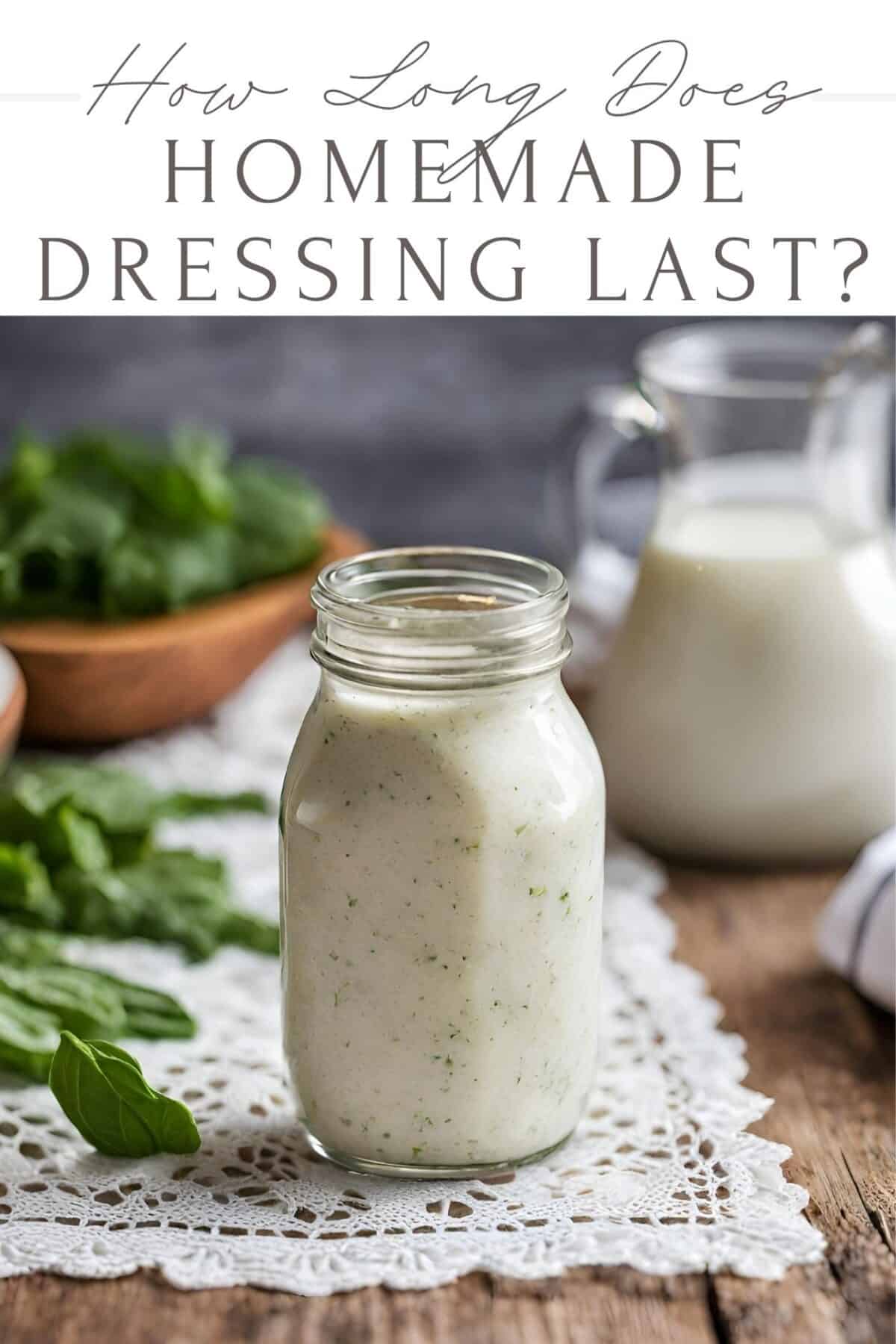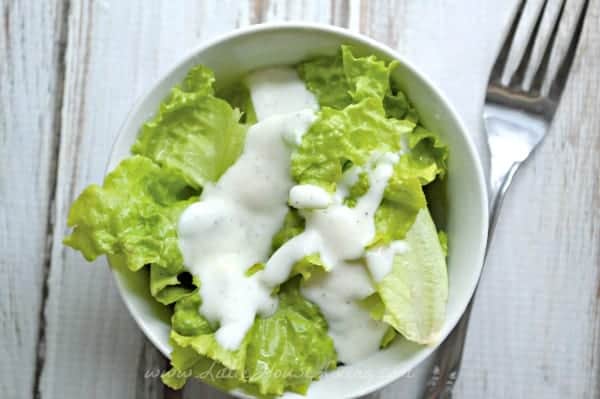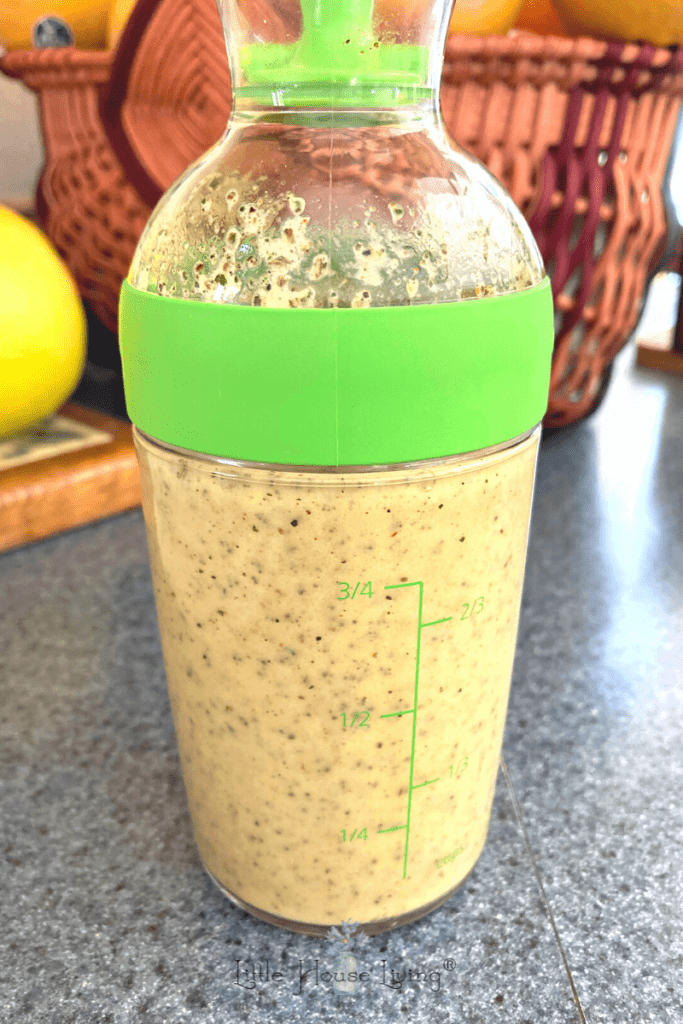How Long Does Homemade Ranch Dressing Last in the Fridge?
This post may contain affiliate links. Read our disclosure policy here.
Homemade dressings can be so rewarding to make! They taste so good, and they can be made from pennies on the dollar compared to store-bought dressings. Here are some good storage method ideas for how long they can last in the fridge.

How Long Does Homemade Dressing Last?
Have you ever wondered how long homemade ranch dressing lasts in the fridge? Crafting it from scratch demands a bit more effort than grabbing a ready-made bottle, but the unmatched burst of fresh, creamy, and herby flavors justifies the extra kitchen hustle.
Homemade ranch dressing lasts 1-2 weeks in the fridge, depending on how you store it. To make your dressing last longer, it’s recommended to refrigerate the dressing right. Keep it in airtight containers, and avoid cross-contamination during preparation and serving.
With these tips, we will get rid of unnecessary waste as we dive into the factors influencing the shelf life of homemade dressings. Plus, we’ll uncover some helpful tips to stretch that delectable ranch dressing journey even further.

How Long Does Homemade Ranch Dressing Last in the Fridge?
Homemade ranch dressing can typically last from 1 to 2 weeks in the fridge if it’s stored properly.
Generally, the shelf life of different salad dressings can vary depending on the ingredients used. So, let’s quickly compare how long different types of salad dressings tend to last in the fridge based on their ingredients.

The Shelf Life of Different Homemade Dressings
The following table shows different types of dressings and their ingredients, comparing their shelf lives:
| Type of Dressing | Main Ingredients | Estimated Shelf Life |
|---|---|---|
| Vinaigrette Dressing | Olive oil, vinegar (red wine vinegar, balsamic vinegar, etc.), Dijon mustard, garlic, herbs, salt, and pepper. | It can last 1-3 weeks in the fridge. The acidity from the vinegar acts as a natural preservative. |
| Creamy Ranch Dressing | Buttermilk, mayonnaise, sour cream, garlic, herbs (usually dill and parsley), onion powder, salt, and pepper. | It can last 1-2 weeks in the fridge due to the dairy content. |
| Caesar Dressing | Anchovies, garlic, Dijon mustard, egg yolk, olive oil, Parmesan cheese, lemon juice, salt, and pepper. | It can last 1-2 weeks in the fridge. The anchovies and egg yolk may contribute to a shorter shelf life. |
| Thousand Island Dressing | Mayonnaise, ketchup, sweet pickle relish, onion, garlic, vinegar, Worcestershire sauce, salt, and pepper. | It can last 1-2 weeks in the fridge. The mayonnaise and perishable components may contribute to a shorter shelf life. |
| Blue Cheese Dressing | Blue cheese, mayonnaise, sour cream, buttermilk, garlic, lemon juice, salt, and pepper. | It can last 1-2 weeks in the fridge due to the dairy content. |
| Italian Dressing | Olive oil, red wine vinegar, garlic, Dijon mustard, herbs (oregano, basil, thyme), salt, and pepper. | It can last 3-4 weeks in the fridge. The oil acts as a natural preservative. |
| Lemon Herb Dressing | Olive oil, lemon juice, garlic, Dijon mustard, herbs (such as parsley, thyme), salt, and pepper. | It can last in the fridge for about 2-3 weeks. The acidity of the lemon juice acts as a natural preservative. |
As you can see from the table, vinegar-based and oil-based dressings generally have a longer shelf life compared to creamy or dairy-based dressings due to the natural preservative properties of vinegar and oil.
However, it’s important to note that these are general estimates, and the actual shelf life of these dressings can vary based on other factors, which we’ll get into in more detail.

Factors That Affect How Long Homemade Dressing Lasts in the Fridge
Several factors influence the shelf life of homemade salad dressings. Here’s a detailed look at each of these factors:
1. Freshness of Ingredients
The ingredients used in the dressing affect its shelf life. For example, dressings with a high dairy content, such as buttermilk or sour cream, tend to have a shorter shelf life due to the perishable nature of dairy products.
The quality and freshness of the ingredients also affect the shelf as fresh herbs and perishable items contribute to a shorter lifespan compared to processed or dried alternatives.
2. Type of Storage Container
Storing your dressing in airtight containers helps prevent exposure to air, which can lead to oxidation and a faster breakdown of ingredients, which ultimately leads to spoilage.
3. Temperature of the Fridge
Storing the dressing at a consistent temperature in the refrigerator is crucial, as sudden temperature changes, like placing a warm dressing into a cold fridge, can accelerate bacterial growth and spoil the dressing faster.
4. Hygiene Practices
The utensils, bowls, and containers used in the preparation and handling of the dressing should be clean, as cross-contamination can introduce bacteria, leading to a quicker deterioration of the dressing.
5. Oil and Acid Balance
Homemade dressings often contain a combination of oil and acidic components. Achieving a proper balance between oil and acid is crucial for the stability of the emulsion. An unstable emulsion can separate, affecting both the taste and texture of the dressing.
6. Preservatives
While homemade dressings may lack the preservatives found in many store-bought options. Some ingredients, such as vinegar, citrus juices, and certain herbs, can act as natural preservatives, which can help extend the shelf life of the dressing by inhibiting the growth of bacteria and fungi.
By paying attention to these factors, you can enhance the longevity of your homemade dressing and ensure a flavorful and safe addition to your salads or dishes.
Still, always use your best judgment and err on the side of caution if you aren’t sure about the dressing’s freshness.

Does Store-Bought Ranch Dressing Last Longer in the Fridge?
Store-bought dressing often includes preservatives and stabilizers specifically formulated to extend its shelf life and make it last longer.
These additives help inhibit the growth of bacteria and fungi, preventing spoilage and maintaining the dressing’s quality for extended periods. Common preservatives in commercial dressings include phosphoric acid, sorbic acid, and various gums.
Additionally, store-bought dressings typically undergo aseptic packaging or other advanced preservation methods during manufacturing. Aseptic packaging involves sterilizing the dressing and packaging it to prevent the reintroduction of microorganisms, ensuring a longer shelf life without refrigeration until opened.
On the other hand, homemade ranch dressing often lacks these commercial preservatives and may have more fresh ingredients, such as dairy and herbs, which are more prone to spoilage.
What Is the Shelf Life of Store-Bought Ranch Dressing?
Once opened, store-bought ranch dressing typically remains fresh for about 1 to 2 months if refrigerated and stored according to the manufacturer’s instructions. When unopened, it can last for several months, and sometimes even up to a year, beyond the purchase date.
It’s important to note that even though store-bought ranch dressing may have a longer shelf life, it’s crucial to check the expiration date on the label and follow any storage instructions provided by the manufacturer.

How to Tell If Your Ranch Dressing Has Gone Bad
Identifying whether your ranch dressing has gone bad involves using your senses to detect any changes in color, smell, or texture. Here are 5 signs to look out for:
1. Off Odor
- Normal Smell: Fresh ranch dressing has a characteristic creamy and tangy aroma with notes of herbs.
- Spoiled Smell: If the dressing develops a rancid or sour odor, it likely indicates spoilage. An off or unpleasant smell is a clear sign that the dressing should be discarded.
2. Changes in Color
- Normal Color: Ranch dressing is typically white or off-white, depending on the specific ingredients used.
- Spoiled Color: Any significant changes in color, such as discoloration or the development of mold, are indicators of spoilage. Discoloration may manifest as a yellow or green tint.
3. Changes in Texture or Separation
- Normal Texture: Well-mixed ranch dressing has a smooth and creamy texture.
- Spoiled Texture: If the dressing has separated into watery and chunky components, it has likely gone bad. Separation can occur due to spoilage or improper storage.
4. Visible Mold
- Normal Appearance: Ranch dressing should not have any visible mold growth.
- Spoiled Appearance: If you observe mold or any unusual growth on the surface or throughout the dressing, it is unsafe to consume.
5. Change in Consistency
- Normal Consistency: Ranch dressing should have a consistent and creamy texture.
- Spoiled Consistency: Any significant changes in consistency, such as curdling or an unusual thickness, may indicate spoilage.
If you notice any of these signs, it’s recommended to err on the side of caution and discard the ranch dressing. Consuming spoiled dressing can pose health risks due to the growth of harmful bacteria.
How to Store Homemade Dressings
Properly storing homemade dressings is crucial to maintaining their freshness and preventing spoilage. Follow these guidelines to store homemade dressings effectively:
- Refrigerate Promptly: Homemade dressings typically contain perishable ingredients, such as dairy or fresh herbs. Refrigerate the dressing promptly after making it to slow down bacterial growth and maintain its quality.
- Monitor Refrigerator Temperature: Ensure that your refrigerator is set to the proper temperature (ideally at or below 40°F or 4°C) to slow down bacterial growth and maintain the freshness of the dressing.
- Use Airtight Containers: Transfer the homemade dressing to a clean, airtight container to prevent exposure to air, which can lead to oxidation and spoilage. Consider using glass or plastic containers with tight-sealing lids.
- Label and Date: Label the container with the type of dressing and the date it was made. This makes it easier to track its freshness and ensures you use it within a reasonable timeframe.
- Avoid Extended Room Temperature Exposure: Minimize the time the dressing spends at room temperature. If you’re serving the dressing at room temperature, return any leftovers to the refrigerator promptly.
- Freeze Small Portions: If you’ve made a large batch of dressing, consider freezing smaller portions in ice cube trays. Thaw individual portions as needed to avoid repeatedly thawing and refreezing the entire batch.
- Check for Signs of Spoilage: Regularly inspect the dressing for any signs of spoilage, such as changes in color, texture, or odor. If you notice anything unusual, it’s safer to discard the dressing.

Other Tips to Make Your Homemade Dressing Last Longer
In addition to proper storage practices, here are some additional tips to help extend the shelf life of your homemade dressing:
- Use Fresh Ingredients: Start with fresh and high-quality ingredients. The better the initial quality of the ingredients, the longer the dressing is likely to last.
- Balance Oil and Acid: Achieve a proper balance between oil and acidic components. This helps create a stable emulsion, reducing the risk of separation and spoilage.
- Consider Adding Natural Preservatives: Some ingredients, such as mustard, honey, or certain kinds of vinegar, can act as natural preservatives. Consider incorporating these into your dressing to help extend its shelf life.
- Consider Pasteurized Ingredients: Use pasteurized or heat-treated ingredients, especially if your dressing contains eggs or dairy. Pasteurization helps kill harmful bacteria and extends the shelf life.
- Store Herb-Infused Oils Separately: If your dressing contains fresh herbs infused in oil, consider storing the herbs and oil separately. Mix them together just before serving to preserve the freshness of the herbs.
- Shake Well Before Use: Before using the dressing, give it a good shake to re-emulsify the ingredients. Some separation may occur during storage, and shaking helps restore the original consistency.
- Avoid Overmixing: While it’s important to mix the dressing thoroughly, avoid excessive blending or processing, as it can introduce more air and contribute to oxidation.
- Rotate Stock: If you frequently make different dressings, rotate your stock by using older dressings first. This ensures that you’re consistently using the oldest dressing before it reaches the end of its shelf life.
By combining these tips with proper storage practices, you can significantly increase the longevity of your homemade dressing and enjoy its flavors for an extended period. Remember to always trust your senses and discard the dressing if you notice any signs of spoilage.
I hope this gives you better insight into how to store your homemade dressings and make them last as long as possible. Let’s work on getting rid of the food waste!

Homemade Dressing Recipes
- Homemade Catalina Dressing Recipe From Scratch
- Easy Homemade Italian Salad Dressing Mix Recipe
- Homemade French Dressing Recipe
- 5 Amazingly Simple Homemade Salad Dressings Worth Trying
- Easy Salad Dressing Recipes
- Russian Salad Dressing Recipe
- Homemade Dorthy Lynch Dressing
- Homemade Ranch Dressing

Merissa Alink
Merissa has been blogging about and living the simple and frugal life on Little House Living since 2009 and has internationally published 2 books on the topic. You can read about Merissa’s journey from penniless to freedom on the About Page. You can send her a message any time from the Contact Page.
This blog post on How Long Does Homemade Ranch Dressing Last was first posted on Little House Living in January 2024.


